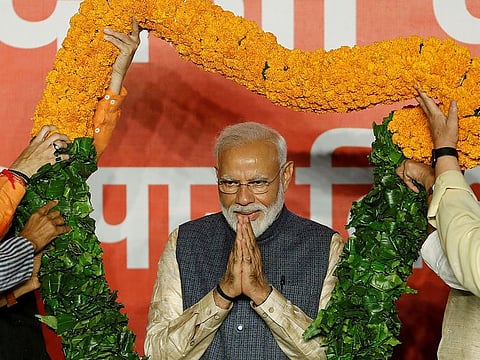India: 2019 general elections will be remembered for many ‘firsts’
The recent general election had many moments and occasions to savour

Dubai: For a nation where politics is second-nature to its myriads of public functionaries, where pampering voters with gifts ranging from television sets to cheap rice is par for the course and where voter-discretion can be a lesson for the wider world — majority of Odisha voters being a case in point this time around, voting for two different parties for simultaneous elections to assembly and parliament elections — the five-yearly battle at the hustings to choose the next government is one of the surest and arguably one of the most potent ways for the man on the street to feel politically empowered. So much so, that a general election in the world’s largest democracy extends way beyond the purview of a mere exercise of universal adult franchise and acquires an almost carnivalesque atmosphere.
The 2019 general elections will probably be remembered in the annals of India’s political history for many ‘firsts’. Right from a prime minister winning an absolute majority for the second time in a row to a record turnout of voters, the 17th Lok Sabha (Lower House of parliament) elections saw several milestones being laid on the political firmament.
From those daily labourers in Mumbai, who had come all the way to cast their votes to their native villages in eastern Uttar Pradesh — even at the risk of losing their jobs for having taken unscheduled leaves — to that nonagenarian lady who braved the mid-May heat to stand in a serpentine queue in one of the polling booths in the hinterlands of Rajasthan, this election had many ‘moments’ and many occasions to savour.
Here we present some of the salient features that characterised the largest political exercise in the world.
PM with absolute majority:
For the first time since 1971, an incumbent prime minister won a second consecutive term of office with an absolute majority in the 2019 general elections. In 1971, the then prime minister, Indira Gandhi of the Congress (R) party, had won the elections with an absolute majority for the second consecutive time, after her win in 1967. In May 2019, incumbent PM Narendra Modi of the Bharatiya Janata Party won an absolute majority for a second consecutive term for his party. However, Modi’s achievement is probably bigger than Indira’s given the fact that unlike Modi, who completed a full five-year term for his party, going into the 2019 elections, Indira did not have a full term before the 1971 elections because she became PM in 1966 only after incumbent PM Lal Bahadur Shastri’s death. In that sense, Modi happens to be the first PM to win two consecutive full terms with an absolute majority since Jawaharlal Nehru’s election wins in 1957 and 1962.
Voter turnout:
According to figures released by the Election Commission of India, in the 2019 general elections, the total voter turnout was 67.11 per cent — the highest since the first general elections took place in 1952. In fact, the 2019 turnout was 1.16 percentage points higher than the 2014 figure. Such a large voter turnout during that time of the year — mid April to mid May — when vast swathes of the country, particularly the Gangetic plains and the western parts experience severe heatwaves and prolonged dry spells. Among the states, Madhya Pradesh registered the highest voter percentage of 75.38, closely followed by West Bengal with 75.31 and Jharkhand with 71.16. Andhra Pradesh, Assam, Gujarat and Karnataka recorded their highest voting percentage since 1962, while in Maharashtra, the figure was at a 30-year high.
Female voters:
For the first time in the history of general elections in the country, the number of female voters almost matched the number of male voters. Initial figures suggest that the number of female voters who exercised their franchise during the 2019 general elections was just 0.04 per cent less than the number of male voters. In fact, some statisticians are of the opinion that once the complete figures are out, they may reveal female voters having actually surpassed the number of male voters for the first time ever. For a country where, since its independence in 1947, women’s participation in the political sphere has been abysmally low, a large number of females going out to exercise their voting right is an extremely significant pointer towards more women seeking empowerment and a bigger share of the political pie.
Sign up for the Daily Briefing
Get the latest news and updates straight to your inbox

